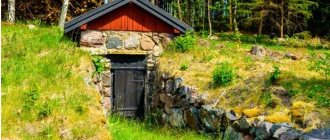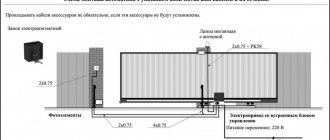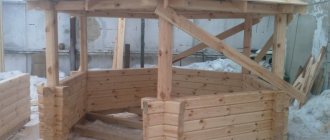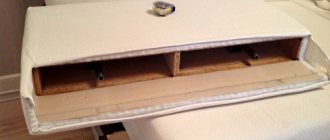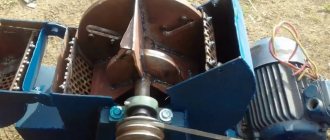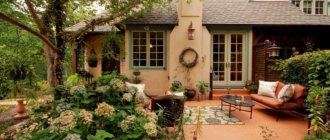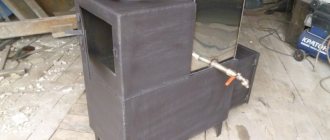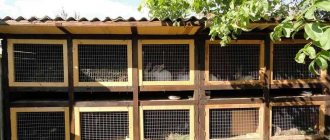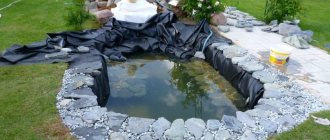Good old houses made of rounded logs are still an example of comfort and warmth. Such housing hardly releases heat, is very strong and can last for decades. Technology has long moved away from rickety huts and in this article you can see photos of modern houses made of rounded logs.
Modern tendencies
We must remember that the latrines of today are significantly different from those of several decades ago. What is this connected with? First of all, with the change in the environmental situation, which is not for the better, which is why the requirements for sanitary standards have become stricter.
Helpful information:
- How to make 3D floors with your own hands
- Do-it-yourself septic tank from Eurocubes
- How to make a self-leveling floor with your own hands
- DIY concrete countertop
- Do-it-yourself wall chipping
- How to make a wooden floor with your own hands
Innovations in the field of waste processing and disposal, which have become more accessible to the general public, also played an important role. Modernity dictates its own rules regarding the design and comfort of toilets, and this is reflected in preferences. The place where people relieve themselves should now be not only ergonomic, but also attractive.
Do you want to make a toilet with your own hands, spending only 7,500 rubles?
Download the country toilet project for free.
Based on all of the above, you can slowly begin building a toilet on your summer cottage. We will touch upon the topic of capital structures made of brick and concrete lightly, but will pay more attention to the external design, which is also of great importance. Like, for example, in this photo:
By the way, the advertised toilet cabins made of corrugated sheets on a metal frame are not very comfortable, because in the summer they are parka in the heat, and in the cool season, on the contrary, they are very cold. They are unlikely to be suitable for installation in a summer cottage. A good option is industrial metal cabins with internal lining and insulation. And it costs less than carpentry.
Of course, the external attractiveness of a latrine is important, because it is much more pleasant to relieve yourself in a beautiful environment. But first of all, you need to take care of the construction process itself and find out what and how to do in order to get a good result. Points that you should definitely consider when building a toilet at your summer cottage:
- Based on external factors, you need to choose a method of waste neutralization, type of drainage and drainage system.
- Choose the exact location where the toilet will be located.
- Think about what the appearance and design of the booth will be. This also includes external and internal design.
- It is imperative to draw up a cost estimate in order to more or less accurately calculate future costs.
Solving these issues will require a certain amount of money, energy and time. Moreover, the easiest and least expensive of all the links is the ground structure (cabin or booth), but the rest will require a lot of work. But let's start, after all, with the booth.
Supports and foundation
As for the basis for the toilet, that is, the foundation, then, oddly enough, you can do without it. And that's why. The fact is that with seasonal shifts in the soil, deeper layers undergo greater changes, while the surface layers can move by 5 centimeters on average. This will not at all disturb the stability of the cabin, perhaps just a little, which will be completely unnoticeable. And piles, foundation strips and pillars, on the contrary, tend to be more skewed.
If it is decided to install the foundation, then this must be done before the cold weather to avoid the above-mentioned problems. The exception is foundations that are well buried in the soil (calculator), these can easily withstand winter and frost.
We build from wood according to traditions
Despite the abundance of materials on the construction market, including innovative ones, wood remains the most popular in the construction of toilets.
Advantages of wood:
- Environmental friendliness. When the boards have served their purpose, the latrine can be dismantled and burned in the oven.
- Decorative. Even the most simple wooden toilet easily fits into the design of any summer cottage, emphasizing its natural beauty.
- Hygiene. Wood absorbs unpleasant odors, masking them.
- Durability. If you use special impregnations against bacteria, fungi and insects or paint that protects against harmful ultraviolet radiation, you can significantly extend the service life of the material.
- Low cost.
The main disadvantage of wood is its increased flammability, which can be reduced by treating it with heat-resistant agents.
A simple latrine can be built in one day
So how do you install a cabin without a base?
Everything is very simple. To do this, concrete posts for trellises are taken, and a booth is installed on top of them. You can also place the booth on ready-made reinforced concrete monoliths or bricks. But the first option (columns) will be better. In the southern regions, trellis posts are often used for vineyards, and where the climate is not so mild, they are used for climbing plants.
Trellis posts are produced in lengths from 1.2 to 6 meters, with dimensions from 10X12 to 20X30 centimeters. They have a trapezoidal cross-section. On the larger side there are wire rod rigging eyes ranging in size from 6 to 12 millimeters, on the smaller side there are rounded corners. To get the pins on which the booth will be attached to the base, you need to saw the eyes in the middle part with a grinder and straighten them.
If a cesspool is provided for the toilet in advance, then you don’t have to worry about the safety of the rear beam of the cabin, which serves as a support. In this case, the negative chemical environment is not dangerous for the tree.
If your summer cottage is located in an area where there are frequent winds, then the cabin still needs to be strengthened. Profiled pipes (40x40x2) or support posts made of timber (80x80) are well suited for this. In this case, the metal base needs to be concreted about half a meter below the humus layer, and the wooden base must first be treated with hot bitumen, then with rough roofing felt with sprinkling, and then dug to a depth of 30 centimeters.
Larch
Larch is the last on this list, but far from the last in the top of materials. Larch is, first of all, beauty. The texture of this wood is very beautiful, so it should be used in the interior decoration of the house.
In other respects, it is between pine and oak, in almost everything.
Structures, cladding and materials
As a rule, 4 types of lumber are used for the cabin. This:
- edged and unedged boards (“twenty”) or roof slats measuring 50x20;
- for cladding on the outside - edged or tongue-and-groove boards with dimensions from 20 to 30 millimeters;
- for the flooring and toilet seat - tongue and groove boards (40X (120-150));
- frame beam (80x80 or 60x60).
You can replace the sheathing board with OSB (8X20 thick) or waterproof plywood. By the way, you can cut laths from OSB for sheathing. A little more expensive, but in some respects even better, is a tongue-and-groove for sheathing.
The best option for covering the cabin with tongue-and-groove boards is horizontal cladding with belts. In this case, the ridges of the tongues should be directed upwards, and the grooves downwards, which will protect the sheathing from the accumulation of unnecessary moisture in the tongues. The door is sheathed vertically.
Boat planking. Photo:
If the design plan includes curved sections, then it is best to cladding it with boat boards according to the marine type, as shown in the figure. This will be especially good for areas where there is a lot of rainfall, but a little worse for windy areas where tongue and groove piling is best. Using an electric jigsaw with a rotary shoe, you can make a cut edge from a boat board. In this case, it is important to observe the angle of inclination of the visor of the board, which should be within 30 degrees. It should also be taken into account that the canopies of the boards should be directed downward along the slope, as shown in the figure.
It is important to know that after pruning, solid lumber must be treated with special preparations that prevent putrefactive processes - biocides. Afterwards, it is necessary to impregnate it twice with a water-polymer emulsion. This product is affordable and can provide good protection against dampness for many years. You should definitely adhere to a strict impregnation sequence. Otherwise, PVA glue simply will not allow the biocide to cover the wood with a protective film. It is better to treat materials for covering the toilet seat and flooring (from the inside), which face the cesspool or the ground, with bitumen mastic or hot bitumen.
A composting toilet for a summer residence without odor and pumping: which one is better?
Appearance of a toilet for a summer residence
A wooden toilet in a country area is traditionally made in 4 architectural forms, which have funny names. See pictures.
This:
- birdhouse;
- hut;
- house;
- hut.
In the photo you can see the types of wooden toilet stalls.
These models do not have significant differences, but there is a difference between them. Which? Let's consider this issue in more detail.
So:
11 drawings of the country toilet “Birdhouse”
It is even simpler in design, and requires very little land for it. But the structure is considered not very durable, and the “birdhouse” is prone to blowing and does not hold heat well. By the way, these disadvantages apply to all buildings with a pitched roof type. The design of such a structure as a birdhouse toilet is kept to a minimum. But this model is perfect as a summer toilet, on the roof of which you can install a pressure water tank, where the water will be heated by the sun. In addition, such a “load” contributes to greater stability of the cabin. Also, a building of this type can be used as a premises for household needs.
3 drawings of the country toilet "Shalash"
The advantages of this model are: resistance to precipitation and winds, strength, simplicity of design, low material consumption. Disadvantages: it requires a considerable amount of land for construction, as well as the inconvenience that if you miscalculate the capacity a little, you can hit your head, and on both sides. Therefore, you need to take the height along the ridge at least 3 meters, but then you won’t be able to save materials.
8 drawings of the country toilet "House"
The type of toilet called "house" is the most popular. Its design is considered better than a “birdhouse” in terms of strength, and the same amount of land and materials will be needed for construction. A “house” is also more suitable for realizing design fantasies, although it will be more difficult to install a water tank.
6 drawings of the country toilet "Izbushka"
The “hut” is the most complex in design, however, it is very durable and can withstand any vagaries of weather. An interesting cut gives room for imagination; the “hut” can be decorated in any way you like. Well, functionality and ergonomics are generally at their best! Inside you can arrange a hanger, washbasin and shelf, and this will not take up extra space.
Oak
Oak is one of the most popular materials. It has higher strength and is less susceptible to cracking when dried.
Compared to pine, it is less moisture resistant, but it retains heat about the same and is even less susceptible to rotting.
Dimensions of a toilet for a summer residence
The permissible dimensions of the “house” and “birdhouse” on the floor (taking into account the toilet seat) are from 1.5 meters deep and from 1.2 meters wide. The same 1.5 meters for depth are taken for a “hut” with a “hut”, while the traditional width is 0.9 meters. In a hut, this is calculated by shoulder level (within 1.6 meters from the floor for a person of average height with shoes on); in a hut, measurements are taken along the floor. It is noteworthy that in the “Khrushchev” buildings, which are built using blocks, there are toilets measuring 0.7X1.1, but they are not designed for entering in outerwear and country shoes.
However, to build a toilet on a summer cottage, it is still permissible to reduce the width to 1 meter.
According to the rules, there should be at least 40 cm from the head of a person in a standing position to the wall, this is especially important when calculating the angle of inclination of the walls of the hut. In this case, the height from floor to ceiling is optimally 2.1 meters, and above the toilet seat - 1.9 meters. The height of the side of the toilet seat from the floor should be within 50 cm, in contrast to the standard option adopted in apartments, which is 40 cm.
The “birdhouse”, “hut” and “house” models have one common, but in a certain sense, significant drawback: if you do not lock the door, then within 10-20 minutes both the door and the booth will become loose. If this happens repeatedly, the toilet stall risks losing stability. To prevent this from happening, you just need to install the door on barn hinges (as shown in the figure), and then there will certainly be no cause for alarm. Because of its strength, the “hut” is not in danger of loosening, so its door can be safely attached to secret hinges.
Additional recommendations
If you decide to install interior doors in a wooden house yourself, you need to take into account a number of additional recommendations:
- During installation, use a plumb line to correctly check the verticality of the casing posts and door frame.
- All voids between the casing box and the opening are filled with insulation and polyurethane foam.
- When installing the front door, a seal is laid around the perimeter of the frame.
- The door frame must be thick enough to provide sound insulation.
- For reliability, it is better to install doors on three or four hinges; check the quality of the fittings before purchasing.
- If a lock is provided in the door structure, it is placed at a height of 700-1200 mm (distance from the floor).
Making a casing and installing a door (2 videos)
Interior doors in the interior of a wooden house (50 photos)
Construction of a booth
The simplest is to install a “birdhouse”, and the installation process is carried out using 100 mm nails for 60 mm timber or 150 mm for 80X80 mm timber. The sheathing is nailed with 60-70 mm nails.
The entire process of building a birdhouse is shown in the pictures.
Algorithm for constructing a birdhouse model toilet:
- Take roofing felt, then cover the corner slabs (columns) and the load-bearing belt with it. The roofing material should be simple, without sprinkling.
- Then immediately assemble the lower support frame from the timber. Processing is required. Why right away? Because roofing material that is not adapted to ultraviolet rays can quickly deteriorate.
- Then the floor is laid to the front edge of the toilet seat. The pieces of the remaining frame are filled with boards of the same thickness as for the floor. We also don’t forget about processing (especially on the inside).
- We prepare the back and front frames, while the joints are cut into half the tree.
- The backdrop and front frame are nailed to the bottom and reinforced with ties. The ties should be 1/4 embedded.
- The frame for the toilet seat is made in the same way.
- The toilet seat needs to be sheathed, then the seat window needs to be cut out, and then we can start covering the walls.
- Assembling roof cladding.
- The roof deck is made of any rigid roofing material. A figured window (the so-called “ace”) is cut out in the door leaf and above the door itself.
- The door canopy is made and the corners are sheathed.
Now the room is quite suitable for use.
“Izbushka” is also a fairly popular model, but it is also more difficult to build. Therefore, below are projects that indicate exact calculations of the material and cutting of the boards. An example drawing is also provided. It should be noted that the door in the “hut” has a high degree of strength and can withstand any bad weather, even strong winds. Even if the owner forgetfully leaves the door open for some time, the wind, of course, will loosen it, but will not damage the door leaf and repairs will be kept to a minimum.
Design of a toilet cabin model “hut”: photo
Below are less detailed drawings of several more projects: “birdhouse” (second option), “house” and “hut”. However, for those who have already understood how to build a “hut”, it will be much easier to understand the above models.
Drawings of several options for toilet stalls: photos
Spruce
Spruce is like pine at maximum settings. It is more moisture resistant, retains heat better, and during processing produces many times fewer splinters, making it perhaps the best material.
Outbuildings
In suburban areas, it is traditional to combine a toilet, shower and outbuildings. They are also sometimes accompanied by summer kitchens and a place where you can hide from rain or wind (if there is no house on the site). This is all completely correct and justified. And that's why.
The fact is that in a summer cottage, the amount of “gray” water that ends up in the drain after using water in the shower or in the kitchen is significantly less than fecal water. And compared, for example, with a residential building, the volume of drainage is small. Therefore, it makes no sense to make this same drain separate. An acceptable and frequently used option for waste disposal in a utility room is a cesspool. Below are examples of how to make a utility block along with a shower and toilet in a summer cottage.
Bacteria for septic tanks and cesspools
Plan of the utility block "Cheburashka": photo
This model of a utility room with a funny name was invented during the Khrushchev Thaw. Sets of parts for the Cheburashka can be purchased now, and, what’s most interesting, under the same names as before. The big advantage of this option is its reasonable price, functionality, simplicity and minimum footprint. In this case, the support pillars are concreted or dug directly into the ground (corrugated pipe 40x40x2, and timber 100x100). Sheathing is currently done using corrugated sheets, but previously it was customary to sheathe with slate.
The presented figure shows several plans for utility units, more complex in design:
Layout of utility blocks with a “change house”: photo
They consist of large rooms that include a barn or warehouse, a shelter from the weather, and a kitchen. Also, such a room requires the installation of a window in it. You can also arrange a mini-room with a sofa, table and chair. Entrance to the shower and toilet is from the street. So, a considerable area of such a building is quite a winning option.
The figure below shows a utility room, which is optimally suited for its construction in the corner part of the site. This option involves installing a washbasin according to the summer type, that is, in the open air. The main difference of this type of structure is its maximum compactness and very small dimensions. It is noteworthy that the plan of the building is brick, but if it is made of wood, then the size of the premises in the plan can be reduced to 2x2 meters.
Corner utility block plan: photo
Walling
At the next stage of building a turnkey house from rounded logs, it is necessary to lay the strapping. In the middle of the foundation, support beams made of aspen and larch are laid in two rows and then fastened. Fixation occurs with reinforcing pins through through-type holes. The beams are treated with bitumen mastic.
Then you need to take embedded half-logs. The bottom of them is cut off to form a flat surface. Then the storm tide is recorded.
Remember, the logs must be laid out parallel. A new row of logs is placed on the free walls. It overlaps the previously laid ones. Corners and joints must have a groove.
This is how the bundle of used logs is produced. Stability is ensured by the use of metal brackets. Using dowels, the embedded crowns must be firmly secured to the strapping.
- Balusters - definition, installation, design and creation with your own hands (70 photos)
- Window shutters - main types and DIY options (65 photos)
Pine doors: affordable ecology. Description of all features and disadvantages
The logs are laid vertically one on top of the other in the grooves. Tape insulation is laid on the longitudinal groove of the previous log. It is recommended to use hemp or tow.
After placing the log in the groove of the previous one, it is necessary to strengthen it using a wooden stake, i.e. dowel. He joins 2-3 logs together. Do not allow the logs to rotate when drilling holes. Therefore, temporary fastening with nails is done. The diameter of the drill used is 5 mm smaller than the size of the dowel, the diameter of which is usually more than 20 mm.
The logs are tied by driving a dowel into a hole drilled through several logs. Maintain a step between fastenings - 1-1.5 m. It is advisable to use chess technology - for every fourth log the dowel is shifted. After complete fixation, the temporary nails are removed.
Don't forget about caulking. To do this, the heat-insulating material is compacted in the inter-crown joints. You can add the material directly to the joint or place it when laying the crowns.
cesspool
Cesspools are a separate issue. The nuances of their construction and how you can do without them altogether will be discussed below.
Installing a toilet on the street: photo
And this picture shows a diagram of the construction of a utility block and a toilet in the yard. Particularly noteworthy is reflector 1, which is one of the main components of the toilet, because it directs feces to the front part of the drainage pit. Then the entire mass gradually slides into the so-called pumping pocket. During this process, the shed masses are mixed with bacteria. It is thanks to the reflector that the correct biocenosis occurs. If you do not use it, then you will need a hole 2 times deeper and larger in volume. “Grey” waste can drain into a pit without a reflector and also end up in the front part. In order to avoid infiltration into the ground, it is imperative to use a blind concrete box 4 and a clay lock 3. An inspection and cleaning door 2 is also extremely necessary.
Pine
Pine is a very popular material. The wood is quite hard and holds heat very well. It is also very resinous, which helps with drying because the resin gets into the pores where there was moisture and hardens.
This process is very useful because it adds moisture resistance and also reduces the risk of rot and rotting in general.
Country toilet in the house
It is quite possible to install a country toilet at home, however, you need to know important rules and solve a number of problems that may be encountered during the installation process. So:
cesspool
It must be remembered that draining wastewater into a well with infiltration into the ground is almost impossible. Otherwise, you will have to adhere to certain distances that are prescribed in sanitary standards. This:
- from water supply sources, a distance of at least 30 meters is accepted, and with traditional geology (in the middle zone) - from 50 to 80 meters;
- the distance from plantings of food crops and stagnant bodies of water should also be 30 meters;
- the distance from flowing bodies of water (rivers and streams) is taken to be 15 meters;
- from road surfaces and buildings - 5 meters;
- from the border of the site, bushes and non-fruit trees - from 2 meters.
It must be taken into account that these rules apply not only to objects on your own site, but also on the sites of your neighbors. And, as they say, you can’t joke with this, because in case of violations on your part, the law will be on the side of your neighbors.
Therefore, it is very important to understand that a toilet in a summer cottage must be built with a blind-type cesspool, which can sometimes be pumped out if necessary. Modern and improved products designed for cesspools can help with this. Sanitary barrels usually travel out of town once a season, and by making an agreement with your neighbors, you can divide the cost of the call among those who use the services.
Smell
Installing a toilet with a flush system and a siphon is not permitted even in areas that have a constant water supply. Why? The fact is that due to water there will be an excess accumulation of moisture, which can have a detrimental effect on the bacteria that we really need that live in the pit. As a result, an almost emergency situation may occur and you will have to call a special service and carry out serious cleaning.
However, installing a backlash closet does not exclude the possibility that unpleasant odors will not penetrate into the room. This can happen for rather trivial reasons: due to the blowing of the ventilation draft by the wind and its surges. But there is a solution to this problem. In order to avoid the above-mentioned misunderstandings, it is necessary to provide ventilation with a traditional fan pipe or breather. It is a ventilation with forced draft, due to which a pressure below atmospheric is formed in the pit.
You should not install a fan on the breather duct - this will do absolutely nothing. After all, an ordinary household fan will not be able to function for a long time in an aggressive environment. There are special fans designed for such purposes. However, they are quite expensive. Such fans must be explosion-proof, and they will also need to be cleaned frequently.
In a house with heating, it will be quite easy to install a country closet. Options for boiler and furnace are shown in the pictures. How to do it? One of the most important links is the installation of a backlash channel with thermogradient draft under the breather. You also need to pay attention to the fact that the breather pipe must protrude at least 70 cm above the ridge of the roof and the mouth of the chimney. And in order for the hood to function well even in the warm season (when there is no heating), you need to take a metal pipe and paint it black, which, as you know, attracts heat on sunny days.
Ventilation of cesspools in houses with heating: photo
There are also toilet options for cottages without heating. Which? To begin with, let’s give an example: in the first “Khrushchev” buildings, fairly large toilets were installed, and the flush was so powerful that no brushes or other attributes were needed. This draining force was achieved due to the fact that the barrel was suspended almost from the ceiling, the height of which was 2.8 meters. On the side of the barrel there was a chain with a pear, with the help of which the draining process was carried out. Thus, the height of the flow of water falling down was about 2 meters.
The noise that arose as a result of the release of water was very loud. Subsequently, they came up with models of compact toilets, where the barrel was located on the back side of the seating area.
At first, the toilets were shaped like sinks with a basin, but with low water pressure, the contents were almost impossible to flush away. Then they came up with toilets with an oblique flush, which was much more convenient. This type of toilet is shown in the picture.
Toilet with oblique and inclined flush: photo
Not so long ago, your humble servant also decided to improve the toilet in a suburban area. I wanted to buy something with a siphon so that there would be no unpleasant odor. A toilet with an oblique flush can flush even without good water pressure. But what if we make pressure, as in Khrushchev’s? This will save water, and the quality of the drainage will remain high.
At first I thought of choosing an inexpensive compact toilet without a dispenser, in which water can be flushed as long as the button is pressed. Then it would be necessary to raise it higher. But then I thought that it would be inconvenient: to stretch high, water is given by the hour, so I additionally need to buy a pressure storage tank.
As a result, I took a “sink” with a direct downward outlet. For water, I took a 50-liter plastic barrel and hung it from the ceiling. I decided to supply the flushing water using two pieces of corrugated plastic through a ball valve with a handle so that it could be opened more sharply.
How to make a sewer system in a country house: all the ways
I was pleasantly pleased with the result, because it only took up to 3 liters of water to flush. And if you calculate the number of flushes per day from a tank with a capacity of 50 liters, then it turns out from 15 to 25 flushes per day. On top of that, the bacteria in the pit feel great in this situation!
It is noteworthy that the cabins described above can also support tanks with a volume of up to 200 liters. However, you should not install them, because frequent draining will oversaturate the pit with moisture, and its contents will begin to overflow and sour. I don't think anyone needs this.
